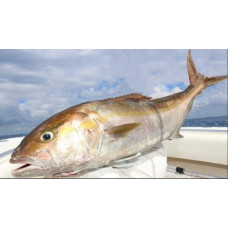Latin name
Seriola dumerili
Other names
Amberjack, jack, amberfish, jack hammer, horseeye bonito, horse-eye jack, Allied kingfish (Australia); French: poisson limon, sériole couronnée; Hawaiian: kahala; Japanese: kanpachi; Spanish: coronado, pez de limón, serviola
Identification
This fish is greenish-blue to almost purple or brown above the lateral line and silvery below the lateral line. A dark olive-brown diagonal stripe runs from the mouth through both eyes to the first dorsal fin. A broad amber stripe runs horizontally along the sides. The fins may also have a yellow tint. The large amberjack has short anterior dorsal fins, the head is bluntly pointed, and the fins are not separated. The amber band sometimes causes fishermen to confuse a large amberjack with a yellowtail, but it can be distinguished by 16 developed gill lobes on the lower extremity, the yellowtail has 21 to 28 gill lobes.
Distribution
In North America, the greater seriola is found off Hawaii, off the coast of Florida, and in nearby Caribbean waters.
Habitat
Found mainly in offshore waters and in considerable depths, and around offshore reefs, shipwrecks, buoys, and oil rigs. They can be caught anywhere in the water column, at depths of up to several hundred feet, but mostly at depths of 60 to 240 feet.
Size
The average amberjack usually weighs up to 40 pounds, can weigh more than 50 pounds and, according to some reports, exceeds 170 pounds. It can be more than 5 feet long.
Life history and Behavior
The Great Amberjack is often found in groups, but is not a gregarious fish. Migrations are associated with spawning behavior, which occurs in the Atlantic from March to June.
Food and feeding habits
The great amberjack feeds on fish, crabs, and squid.
Reproduction
It spawns from March to June. Spawning may occur in coastal ocean waters, but little research has been done. Spawning fish congregate near reefs and shipwrecks.
| Classification | |
| Phylum | Chordata |
| Class | Actinopterygii |
| Squad | Carangiformes |
| Family | Carangidae |
| Genus | Seriola |
| Species | dumerili |
| Features | |
| Conservation status | Least Concern |
| Habitat | Pelagic |
| Life span, years | No information |
| Maximum body weight, kg | 80.6 |
| Maximum length, cm | 190 |
| Sailing speed, m/s | No information |
| Threat to people | Edible |
| Way of eating | Predator |


